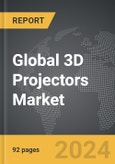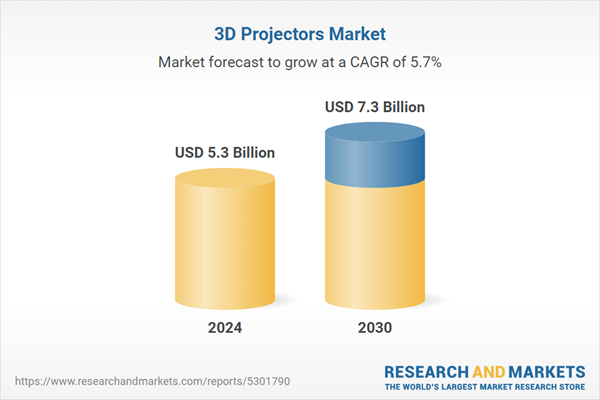Global 3D Projectors Market - Key Trends and Drivers Summarized
How Are 3D Projectors Changing the Way We Experience Visual Content?
3D projectors are transforming the way we experience visual content by bringing immersive, life-like imagery into homes, cinemas, classrooms, and professional settings. Unlike traditional 2D projectors, which display flat images, 3D projectors utilize advanced technologies such as stereoscopic imaging to create the illusion of depth, making objects appear to pop out from the screen. This enhanced viewing experience is particularly impactful in fields such as entertainment, education, and simulation. In cinemas, 3D projectors enable filmmakers to create more engaging, visually captivating movies, giving audiences a heightened sense of realism. For home theaters, the accessibility of 3D projectors means that consumers can enjoy a cinematic experience in the comfort of their own homes. Additionally, in education, 3D projectors are being used to make subjects such as biology, geography, and history more interactive and engaging. Students can visualize complex structures, such as the human body or topographical maps, in three dimensions, enhancing comprehension and retention. As these projectors become more sophisticated, they are increasingly being used for professional applications as well, including in medical training, architectural design, and virtual simulations, where accurate 3D visualization is crucial for decision-making and training.Why Are 3D Projectors Gaining Popularity in Entertainment and Professional Settings?
The growing popularity of 3D projectors in entertainment and professional environments can be attributed to several key factors, particularly their ability to provide a more immersive and realistic viewing experience. In the entertainment industry, 3D projectors have become a staple in cinemas, especially for blockbuster films that rely heavily on special effects and high-impact visuals. Movies like Avatar and the Marvel franchise have demonstrated the potential of 3D technology to enhance storytelling by making viewers feel as though they are part of the on-screen action. The increasing demand for premium movie experiences has driven the adoption of 3D projectors not just in commercial theaters but also in the home entertainment market, where consumers are seeking ways to replicate the cinema experience at home. In professional settings, the rise of 3D projectors is driven by their usefulness in delivering presentations and training that require more than just static, 2D visuals. For instance, in the medical field, 3D projectors are increasingly used to display detailed anatomical models for educational purposes or during surgical planning. Architects and engineers also use 3D projectors to showcase building designs and models, allowing clients and colleagues to visualize projects with depth and accuracy. The ability to present 3D models in real-time helps improve collaboration, speeds up decision-making processes, and enhances communication in these professional environments. The integration of 3D projection technology into these sectors is creating new opportunities for innovation, making it an essential tool in areas where visual detail and immersion are critical.What Challenges Are Limiting the Broader Adoption of 3D Projectors?
While 3D projectors offer a wealth of benefits, several challenges are limiting their broader adoption across both consumer and professional markets. One of the main barriers is the requirement for special viewing equipment, such as 3D glasses, which can be seen as cumbersome or uncomfortable for prolonged use. Although passive 3D glasses are lightweight and relatively inexpensive, some viewers find them inconvenient, particularly in home environments where the casual nature of viewing might conflict with the need for extra accessories. Additionally, active 3D glasses, which are required for some projector models, tend to be bulkier and more expensive, which can deter potential users. Another limitation is content availability. While 3D movies and video games were once a growing market, the production of 3D content has slowed in recent years, particularly in the consumer space, as the initial excitement surrounding the technology has waned. This lack of consistent, high-quality 3D content can make it difficult for users to justify the investment in 3D projectors, especially for home use. Technical challenges also persist, particularly in terms of brightness and image quality. 3D projection often requires higher brightness levels compared to 2D projection, as the splitting of the image into separate frames for each eye can reduce overall luminosity. This means that viewers in brightly lit environments may struggle to achieve the optimal 3D viewing experience without making significant adjustments to their viewing conditions. Additionally, 3D projection technology is still more expensive than its 2D counterparts, particularly when it comes to high-resolution, large-screen setups. The initial cost of purchasing a 3D projector, combined with the need for specialized glasses and a high-quality sound system, can be a prohibitive factor for many consumers and businesses.What Is Driving the Growth of the 3D Projectors Market?
The growth in the 3D projector market is driven by several factors. One of the key drivers is the increasing demand for immersive and interactive experiences, particularly in the entertainment and education sectors. As audiences continue to seek more engaging content, 3D projectors are becoming essential in delivering movies, video games, and virtual experiences that offer depth and realism. This demand is not only limited to cinemas but has expanded into the home entertainment market as consumers invest in premium viewing experiences. The rising popularity of virtual and augmented reality technologies is also contributing to this trend, with 3D projectors providing a bridge between traditional flat-screen content and fully immersive VR experiences. Another significant driver is the growing use of 3D projectors in professional and educational settings. In education, the ability to display 3D models of complex subjects like anatomy, geography, and chemistry is transforming how students engage with learning materials. Schools and universities are adopting 3D projection technology to make STEM subjects more accessible and exciting, which is driving demand for these devices. In the professional world, industries such as healthcare, architecture, and engineering are increasingly relying on 3D projectors to visualize data and models in ways that 2D representations cannot. This technology enables better decision-making, enhances presentations, and improves collaborative efforts across teams. As the technology continues to evolve, advancements in brightness, resolution, and affordability are making 3D projectors more accessible to a broader audience. Moreover, the integration of wireless and smart technologies in 3D projectors is improving ease of use and connectivity, further accelerating market growth. Finally, the ongoing push for innovation in both hardware and content creation is expanding the potential applications of 3D projectors, ensuring their continued relevance in an increasingly digital and visually-driven world.Report Scope
The report analyzes the 3D Projectors market, presented in terms of market value (US$ Thousand). The analysis covers the key segments and geographic regions outlined below.- Segments: Technology Type (Display Light Processing (DLP), Liquid Crystal Display (LCD), Liquid Crystal on Silicon (LCoS)); Light Source (Laser, LED, Lamps, Other Light Sources); Application (Corporate, Cinema, Events & Large Venues, Education, Home Theater & Gaming, Other Applications).
- Geographic Regions/Countries:World; United States; Canada; Japan; China; Europe (France; Germany; Italy; United Kingdom; and Rest of Europe); Asia-Pacific; Rest of World.
Key Insights:
- Market Growth: Understand the significant growth trajectory of the Display Light Processing (DLP) Technology segment, which is expected to reach US$3.5 Billion by 2030 with a CAGR of a 5.8%. The Liquid Crystal Display (LCD) Technology segment is also set to grow at 6.3% CAGR over the analysis period.
- Regional Analysis: Gain insights into the U.S. market, valued at $1.4 Billion in 2024, and China, forecasted to grow at an impressive 5.4% CAGR to reach $1.1 Billion by 2030. Discover growth trends in other key regions, including Japan, Canada, Germany, and the Asia-Pacific.
Why You Should Buy This Report:
- Detailed Market Analysis: Access a thorough analysis of the Global 3D Projectors Market, covering all major geographic regions and market segments.
- Competitive Insights: Get an overview of the competitive landscape, including the market presence of major players across different geographies.
- Future Trends and Drivers: Understand the key trends and drivers shaping the future of the Global 3D Projectors Market.
- Actionable Insights: Benefit from actionable insights that can help you identify new revenue opportunities and make strategic business decisions.
Key Questions Answered:
- How is the Global 3D Projectors Market expected to evolve by 2030?
- What are the main drivers and restraints affecting the market?
- Which market segments will grow the most over the forecast period?
- How will market shares for different regions and segments change by 2030?
- Who are the leading players in the market, and what are their prospects?
Report Features:
- Comprehensive Market Data: Independent analysis of annual sales and market forecasts in US$ Million from 2024 to 2030.
- In-Depth Regional Analysis: Detailed insights into key markets, including the U.S., China, Japan, Canada, Europe, Asia-Pacific, Latin America, Middle East, and Africa.
- Company Profiles: Coverage of players such as Acer Inc., Barco, BenQ Corporation, Boxlight, Canon Inc. and more.
- Complimentary Updates: Receive free report updates for one year to keep you informed of the latest market developments.
Some of the 36 companies featured in this 3D Projectors market report include:
- Acer Inc.
- Barco
- BenQ Corporation
- Boxlight
- Canon Inc.
- Christie Digital
- Dell
- Digital Projection
- Dukane
- InFocus Corporation
- JVCKenwood Corporation
- NEC Display Solutions
- Optoma
- Panasonic Corporation
- Seiko Epson Corporation
- Sim2 BV
- Sony Corporation
- Viewsonic
- Vivitek Corporation
- Wolf Cinema
This edition integrates the latest global trade and economic shifts into comprehensive market analysis. Key updates include:
- Tariff and Trade Impact: Insights into global tariff negotiations across 180+ countries, with analysis of supply chain turbulence, sourcing disruptions, and geographic realignment. Special focus on 2025 as a pivotal year for trade tensions, including updated perspectives on the Trump-era tariffs.
- Adjusted Forecasts and Analytics: Revised global and regional market forecasts through 2030, incorporating tariff effects, economic uncertainty, and structural changes in globalization. Includes historical analysis from 2015 to 2023.
- Strategic Market Dynamics: Evaluation of revised market prospects, regional outlooks, and key economic indicators such as population and urbanization trends.
- Innovation & Technology Trends: Latest developments in product and process innovation, emerging technologies, and key industry drivers shaping the competitive landscape.
- Competitive Intelligence: Updated global market share estimates for 2025, competitive positioning of major players (Strong/Active/Niche/Trivial), and refined focus on leading global brands and core players.
- Expert Insight & Commentary: Strategic analysis from economists, trade experts, and domain specialists to contextualize market shifts and identify emerging opportunities.
Table of Contents
Companies Mentioned (Partial List)
A selection of companies mentioned in this report includes, but is not limited to:
- Acer Inc.
- Barco
- BenQ Corporation
- Boxlight
- Canon Inc.
- Christie Digital
- Dell
- Digital Projection
- Dukane
- InFocus Corporation
- JVCKenwood Corporation
- NEC Display Solutions
- Optoma
- Panasonic Corporation
- Seiko Epson Corporation
- Sim2 BV
- Sony Corporation
- Viewsonic
- Vivitek Corporation
- Wolf Cinema
Table Information
| Report Attribute | Details |
|---|---|
| No. of Pages | 176 |
| Published | December 2025 |
| Forecast Period | 2024 - 2030 |
| Estimated Market Value ( USD | $ 5.3 Billion |
| Forecasted Market Value ( USD | $ 7.3 Billion |
| Compound Annual Growth Rate | 5.7% |
| Regions Covered | Global |









